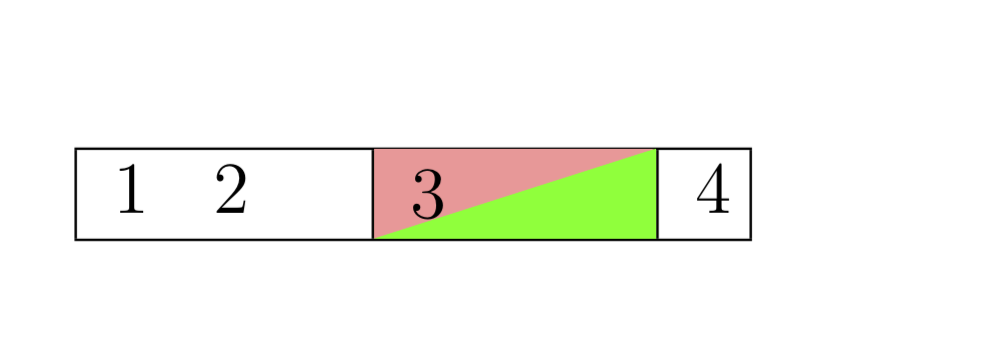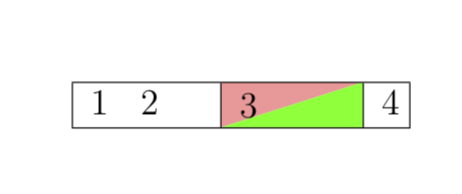|
Mit cellcolor kann ich die gesamte Zelle z.B. grün ausfüllen, ich möchte allerdings entlang der diagonalen eine Trennung, eine Hälfte grün und die andere Hälfte z. B. rot. Ich habe bereits versucht, ein Bild einfügen und darüber zu legen, leider mit mäßigem Erfolg. Öffne in Overleaf
\documentclass[12pt, pointlessnumbers]{scrbook} \usepackage{tabularx} \usepackage{colortbl} \begin{document} \begin{tabular}{|p{0.15cm}p{0.7cm}|p{1.2cm}|m{0.1cm}|m{0.9cm}} \hline 1 & 2 & \cellcolor{green} 3 & 4 \\ \hline \end{tabular} \end{document} |
|
Hier ist eine Methode, die relativ aufwendig ist, aber beliebig komplizierte Hintergrundgraphiken erlaubt: setze in die Zelle eine tikzmarknode, die Du dann mit dem entsprechenden Öffne in Overleaf
\documentclass[12pt, pointlessnumbers]{scrbook} \usepackage{tabularx} \usepackage{colortbl} \usepackage{tikz} \usetikzlibrary{tikzmark} \begin{document} \begin{tabular}{|p{0.15cm}p{0.7cm}|p{1.2cm}|m{0.1cm}|m{0.9cm}} \hline 1 & 2 & \cellcolor{green} \tikzmarknode{3}{\strut 3} & 4 \\ \hline \end{tabular} \begin{tikzpicture}[overlay,remember picture] \node[anchor=south west,inner xsep=\tabcolsep,inner ysep=3.5pt,text width=1.2cm, path picture={\fill[red!40] (path picture bounding box.north west) -- (path picture bounding box.north east) -- (path picture bounding box.south west); \fill[green] (path picture bounding box.south west) -- (path picture bounding box.south east) -- (path picture bounding box.north east);}] at ([xshift=-\tabcolsep]3.south west) {3}; \end{tikzpicture} \typeout{\the\tabcolsep} \end{document} Oder, wie von Ulrike Fischer vorgeschlagen, im Hintergrund. Öffne in Overleaf
\documentclass[12pt, pointlessnumbers]{scrbook} \usepackage{tabularx} \usepackage{colortbl} \usepackage{eso-pic} \usepackage{tikz} \usetikzlibrary{tikzmark} \begin{document} \begin{tabular}{|p{0.15cm}p{0.7cm}|p{1.2cm}|m{0.1cm}|m{0.9cm}} \hline 1 & 2 & \tikzmarknode{3}{\strut \phantom{3}} & 4 \\ \hline \end{tabular} \AddToShipoutPictureBG*{% \begin{tikzpicture}[overlay,remember picture] \node[anchor=south west,inner xsep=\tabcolsep,inner ysep=3.5pt,text width=1.2cm, path picture={\fill[red!40] (path picture bounding box.north west) -- (path picture bounding box.north east) -- (path picture bounding box.south west); \fill[green] (path picture bounding box.south west) -- (path picture bounding box.south east) -- (path picture bounding box.north east);}] at ([xshift=-\tabcolsep]3.south west) {3}; \end{tikzpicture}} \end{document}
normalerweise ist es besser, die Dinge so aufzusetzen, dass die tikzpicture vor der Tabelle ist, dann sind die Farben unter den Tabellenlinien.
(26 Nov '18, 16:36)
Ulrike Fischer
@Ulrike Fischer Kann man natürlich auch machen.
(26 Nov '18, 17:16)
Community
|


